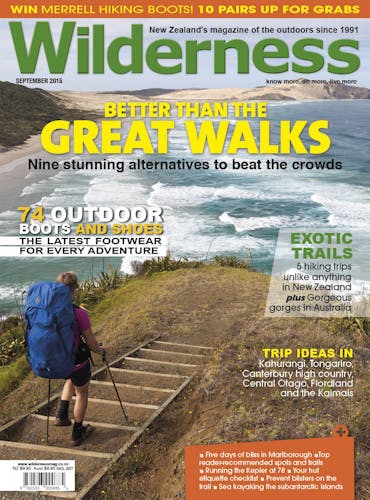Te Araroa isn’t just the name of New Zealand’s long pathway, writes Mick Abbott, it’s the sum of all our journeys that span our first tramps to the last
There’s something in a long tramp that holds out the promise of more than just new places to see. There’s the hope of a personal transformation.
For me it came after a week stuck by crap weather in Godley Hut, and in which the last hut entry came from someone who later vanished on the glacier. In the end, I gave up and walked out of the valley. My footsteps were leaden. I knew whatever other route I might take, I’d given up on my goal of a solo traverse of the South Island.
But by the third song on my Walkman – yes it was that long ago – I had turned around. I let the music and my emotions ride me back past the hut, over a ridge and onto the Godley Glacier. In the evening, it began to snow. Next day, I was jumping crevasses on the other side of Terra Nova Pass, reckless and lost to the mountains.
It was at this point I felt I was beginning to know something deep about this land.
This sense of pilgrimage, of taking a long walk of discovery, is a timeless theme. Rites of passage, Into the Wild, Wild Boy and so on. On the outside, it’s all about learning about places not yet travelled to. But the deeper motive is always personal change.
Travel to the north-eastern corner of Spain and you’ll meet many on an historic pilgrimage to the city of Santiago de Compostela. On the steps of its magnificent cathedral you’ll hear all the languages of Europe – Spanish Scouts at the end of a 25 day walk from the Pyrenees, others who have followed the coastal trail from the north of Portugal. This is a spiritual trek and on completing it they pause and pray at the cathedral, participating in a tradition that goes back centuries.
The walkers that look less certain about what to do have come from much further away, adorned with bright performance outdoor gear, rather than sandals. On arrival, they quickly circuit the nave taking photos as they go. And then it’s over and they depart for the nearby, overpriced cafés for a well-earned beer and the confident discussion that comes from walking part of the Camino Way.
Outdoor magazines routinely profile the walk and the spiritual qualities it promises. However, I’m not sure this walk can ever provide the form of awakening that their readers might hope for.
As historian Paul Carter writes, to clearly see something demands you are fully aware of the place you are seeing from. The promise of the long walk ahead is always bound up in where it is you’re walking from. And unfortunately for many of those flying in, hoping to tap into another place’s heritage, there seems no deeply personal place they are walking from.
I’ve often wondered if the Te Araroa Trail might be a North Islander’s view of the country as they look south. The places that you travel from are the North’s main centres, as the walk gathers up the likes of Auckland, Hamilton, Whanganui, Palmerston North and Wellington. Then once across the strait it heads directly into the hills, away from almost all the South Island’s settlements.
From a South Islander’s perspective, it’s the routes across the Main Divide that have the greatest meaning, not Te Araroa. There’s all manner of crossings, from the Siberia to Ngatau crossing in the south, to the Edwards to Otehake crossing in the north, as it sidles the spectacular Falling Mountain. In each crossing, the contrast in topography, ecology, climate and travel is marked. Many date back centuries when Māori used them as trading routes. Noti Raureka, Browning Pass, is a key crossing that’s part of Canterbury’s popular and rugged Three Pass Trip that involves three main divide crossings in quick succession.
Where to begin our own tramping pilgrimages? For William Grave, deputy head of Waitaki Boys, it began on his bike in the early 1900s when he would ride from Oamaru to Te Anau, then across on a boat to explore the Glaisnock, Worsley and Wild Natives catchments. The journals from these gripping journeys are a must read in Anita Crozier’s Beyond the Southern Lakes.
Rather than a single journey, they built on each year over each subsequent summer – a circular itinerary that linked home and the outdoors.
Shaun Barnett and Chris Maclean in their history of tramping grabbed a quote I’d written after my traverse of the South Island: “At times I wished the South Island was circular so I wouldn’t have to finish and I wouldn’t have to stop.”
At the time, I regretted that our backcountry wasn’t continuous. But now I realise that it is. The long trips are but punctuation points between many shorter journeys. Rather than a grand epic being some high point of tramping, I’ve come to realise the more enduring value of layering up many smaller tramps. Soon I’m off to the Copland for the 10th time, while those three passes have become a friendly place that I keep returning to.
Perhaps that’s the greatest thing that multiple years of tramping can give – the prospect that the place we are travelling to is also the place we are travelling from. There seems little need to fly to another continent to look for something that is waiting to be discovered in the journeys that lead from our back door.
That’s why the long pathway, Te Araroa, isn’t some route than spans from the north to the south. It’s the sum of journeys that span our very first tramps to the last. In this we are all in the midst of a pilgrimage – one that is gently taking us into the wild, rather than merely through it.







